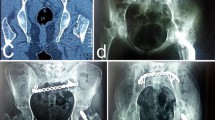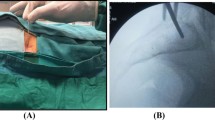Abstract
Fourteen patients with transforaminal sacral fractures were treated with posterior iliosacral instrumentation. Patients were assessed in terms of surgical technique and functional results. A subjective functional scoring with a five-point scale was performed at the last follow-up. Activity pain, pain at rest, limping and patient satisfaction were evaluated. By considering symptom and satisfaction scores, subjective functional assessment revealed that ten patients had excellent results, two good and two moderate. There were no patients with poor functional outcome. The surgical technique is not a new concept. Combining sacral bar and pediculo-iliac fixation methods, provides vertical as well as horizontal stability and allows early weight bearing, the methods has many advantages. However, vertical and horizontal stabilities achieved by this technique may require further assessment with comparative biomechanical studies.
Résumé
Quatorze malades avec des fractures sacrées transforaminales ont été traités avec une instrumentation iliosacrée postérieure. Les malades ont été étudiés en fonction de la technique chirurgicale, et des résultats fonctionnels. Une échelle fonctionnelle subjective à 5 points a été utilisée au dernier examen. La douleur à l’activité et au repos, la boiterie et la satisfaction des patients ont été évalué. En considérant les symptômes et le score fonctionnel, 10 patients avaient un résultat excellent, 2 un bon résultat et 2 un résultat moyen. Il n’y avait aucun mauvais résultat.La technique chirurgicale n’est pas un nouveau concept. En combinant une barre sacrée et les méthodes de fixation pédiculaires , la stabilité horizontale aussi bien que verticale est obtenue, et une remise en charge précoce est possible. Cependant, les stabilités verticales et horizontales obtenues par cette technique peuvent exiger une appréciation supplémentaire avec des études biomécaniques comparatives.


Similar content being viewed by others
References
Bonin JG (1945) Sacral fractures and injuries to the cauda equina. J Bone Joint Surg 27:113–127
Bucholz RW, Peters P (1988) Assesment of pelvic stability. In: Instructional course lectures, The American Academy of Orthopaedic Surgeons, vol 37. The American Academy of Orthopaedic Surgeons, Park Ridge, Illinois, pp 119–127
Bucholz RW (1981) The pathological anatomy of Malgaigne fracture-dislocations of the pelvis. J Bone Joint Surg Am 63:400–404
Bucknill TM, Blackburne JS (1976) Fracture-dislocations of the sacrum. Report of three cases. J Bone Joint Surg Br 58:467–470
Burgess AR (1992) Fractures of the pelvis, part I: the pelvic ring. In: Rockwood CA, Green P (eds) Fractures in adults, 3rd edn. J.B. Lippincott, Philadelphia, pp 1399–1442
Denis F, Davis S, Comfort T (1988) Sacral fractures: an important problem. Retrospective analysis of 236 cases. Clin Orthop 227:67–81
Denis F (1984) Spinal instability as defined by the three-column spine concept in acute spinal trauma. Clin Orthop 189:65–76
Fountain SS, Hamilton RD, Jameson RM (1977) Transverse fractures of the sacrum. A report of six cases. J Bone Joint Surg Am 59:486–489
Goldstein A, Phillips T, Sclafani SJ et al (1986) Early open reduction and internal fixation of the disrupted pelvic ring. J Trauma 26:325–333
Kellam JF, McMurtry RY, Paley D et al (1987) The unstable pelvic fracture. Operative treatment. Orthop Clin North Am 18:25–41
Phelan ST, Jones DA, Bishay M (1991) Conservative management of transverse fractures of the sacrum with neurological features. A report of four cases. J Bone Joint Surg Br 73:969–971
Purser DW (1969) Displaced fracture of the sacrum. Report of a case. J Bone Joint Surg Br 51:346–347
Saiki K, Hirabayashi S, Horie T et al (2002) Anatomically correct reduction and fixation of a Tile C-1 type unilateral sacroiliac disruption using a rod and pedicle screw system between the S1 vertebra and the ilium: experimental and clinical case report. J Orthop Sci 7:581–586
Sar C, Kilicoglu O (2003) S1 pediculoiliac screw fixation in instabilities of the sacroiliac complex: biomechanical study and report of two cases. J Orthop Trauma 17:262–270
Schildhauer TA, Ledoux WR, Chapman JR et al (2003) Triangular osteosynthesis and iliosacral screw fixation for unstable sacral fractures: a cadaveric and biomechanical evaluation under cyclic loads. J Orthop Trauma 17:22–31
Simonian PT, Routt C Jr, Harrington RM et al (1996) Internal fixation for the transforaminal sacral fracture. Clin Orthop 323:202–209
Zelle HA, Gruen GS, Hunt T et al (2004) Sacral fractures with neurologic injury: is early decompression beneficial? Int Orthop 28:244–251
Author information
Authors and Affiliations
Corresponding author
Rights and permissions
About this article
Cite this article
Harma, A., Inan, M. Surgical management of transforaminal sacral fractures. International Orthopaedics (SICOT) 29, 333–337 (2005). https://doi.org/10.1007/s00264-005-0678-y
Received:
Accepted:
Published:
Issue Date:
DOI: https://doi.org/10.1007/s00264-005-0678-y




